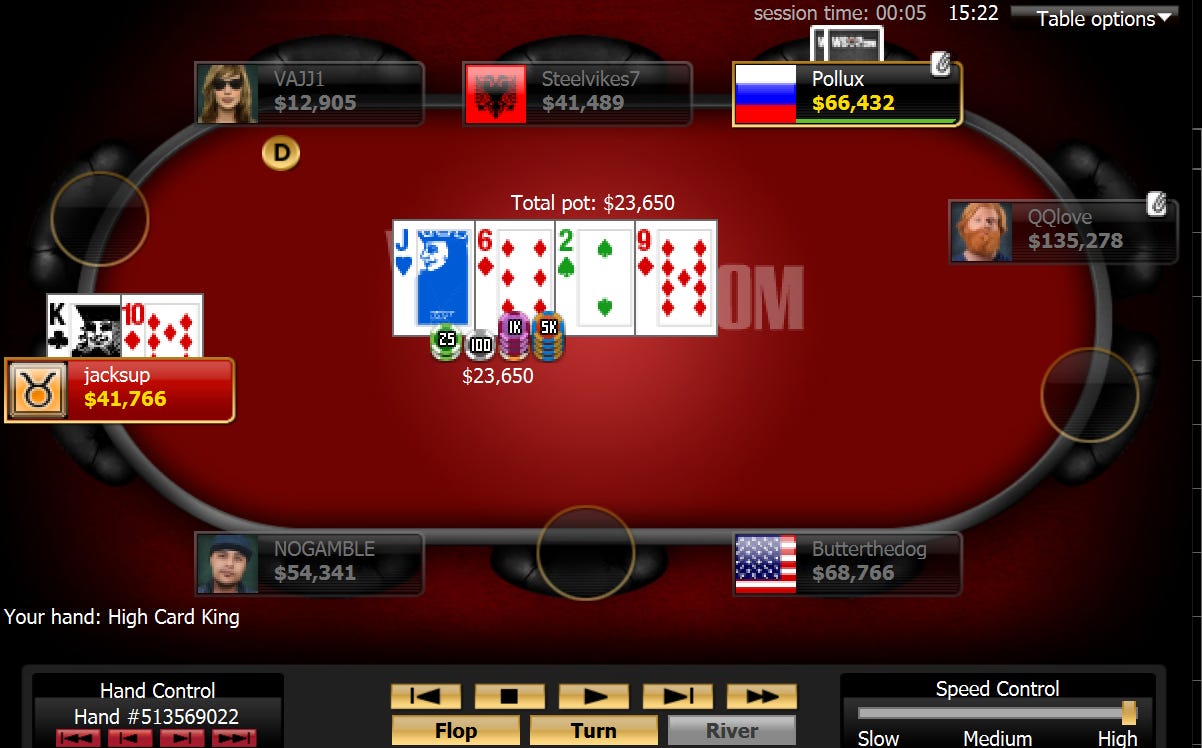Second-to-last Hand Review from 2022
A turn spot from the final online Circuit event of the year
I thoroughly enjoyed playing online Ring and Bracelet events from New Jersey this past year—and with PokerStars recently combining the NJ and MI player pools, it looks like I’ll have many more opportunities to drive across the river for some action in 2023!
But first, let’s look back at my last tournament from 2022.
In the final chance to win a WSOP Ring last year, I was one table away from the money when the following hand occurred.
From a 20 BB stack, I opened for a min-raise of 5k from the cutoff with KcTd. Only the big blind called.
The flop came Jh6d2s. My opponent checked, I continued with a bet of 5k into the 13,650 pot, and the big blind called.
The turn brought the 9d and my opponent checked again. I had 41,766 left, my opponent had me covered, and the pot was 23,650. What’s the play here? Think for a minute before responding to the poll below.
Before we answer, let’s pause to consider the situation overall. The bubble, or just outside it, is one of the most painful places to bust in poker tournaments from a psychological standpoint. Not coincidentally, it’s also one of the spots where it makes mathematical sense to place some of the greatest value on survival.
As illustrated in this fantastic discussion with Dara O’Kearney and Lexy Gavin-Mather, just outside the bubble and the beginning of the final table are the two spots where survival is at the biggest premium. It makes intuitive sense. What are the two most painful places to finish? The stone bubble and ninth, of course. It turns out that ICM agrees, and thinks that you should do everything you can not to have one of those finishes.
By far the best way to take advantage of these situations is to put pressure on shorter stacks who are scared to death of busting. Indeed, that’s my usual plan and that’s usually the role I take on come bubble time. But of course, even I don’t always get what I want, and sometimes I’m stuck with a below-average stack—which brings us back to the hand under discussion.
On the turn, the following factors are all in play:
1) It’s just outside the bubble, where I really don’t want to bust, and my opponent has me covered.
2) My opponent knows I really don’t want to bust.
3) My opponent definitely doesn’t want to double me up and be left with 10 blinds, but that would be less of a catastrophe for them than busting would be for me.
Let’s keep those factors in the back of our minds for now.
OK, after the big blind can only muster a check-call of my flop bet, I’m the player who’s much more likely to have a strong hand. The fairly innocuous 9d on the turn does little to change that, therefore I should be betting often with my range overall. My specific hand can go either way, since the turned gutshot makes a free card somewhat attractive, but I prefer a bet at this stage of the tournament, where people tend to tighten up their calling standards.
Ah, but what size? Here’s where I strongly suspect that an ICM play would look quite different from a chip-EV play. I don’t have a fancy simulator that can handle the bubble of a huge tournament field, but if I did it would probably say that either a small bet, or a huge bet, would make the most sense.
The downside of a big, non all-in bet, is that I still have to fold a huge portion of my range if my opponent shoves, even getting a pretty good price, since it hurts so much to bust. If I want to bet, then, it probably makes sense to keep it small to make an all-in from my opponent as unappealing as possible.
Or, I can eliminate the chance for my opponent to shove over my bet…by simply jamming myself! My opponent doesn’t want to lose a lot of chips either, and should give me credit for a reasonable holding when I risk busting on the bubble. An all-in bet should therefore have a very high chance of working against the big blind’s weak range.
I don’t have a definitive answer here, and I’d love to hear further arguments in favor of one play or the other. I think either a small bet or an all-in bet is a reasonable choice.
In the actual hand, I chose to move all-in. I did so because my opponent was savvy enough and tricky enough to put me to a decision for all my chips with high frequency if I bet a lesser amount, and I thought they wouldn’t want to risk losing two-thirds of their stack with a mediocre hand on the bubble (and I thought a lot of their range contained mediocre hands).
My opponent, thankfully, folded.
I hope you enjoyed this hand. Please consider a paid subscription to help support my work, and to be sure you don’t miss any further discussions/videos/podcasts in the coming weeks and months!


